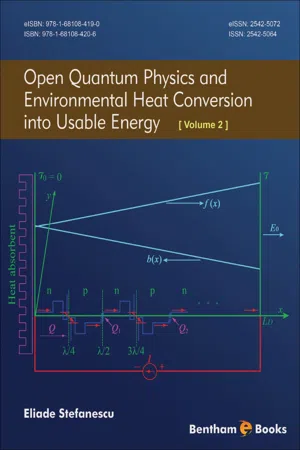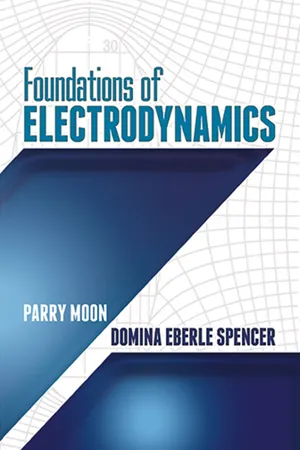Physics
Relativistic Electrodynamics
Relativistic electrodynamics is a branch of physics that combines the principles of special relativity with classical electrodynamics. It describes the behavior of electric and magnetic fields in the presence of high speeds and strong gravitational fields. This theory has been crucial in understanding phenomena such as electromagnetic radiation, particle accelerators, and the behavior of charged particles in magnetic fields.
Written by Perlego with AI-assistance
Related key terms
5 Key excerpts on "Relativistic Electrodynamics"
- Eliade Stefanescu(Author)
- 2017(Publication Date)
- Bentham Science Publishers(Publisher)
2.2.2. Relativistic Electrodynamics In the previous subsection, we showed that a field interacting with a quantum particle is described by a phase variation in the particle wave-function (2.53),(2.84) with a potential four-vector (Ax , Ay , Az − U) conjugated to the space-time four-vector (x,y,z,t) [85 ]. Considering the space-time four-vector
the differential interval (2.33) takes the simpler form(2.85)
while, with the conjugated potential four-vector,(2.86)
the phase variation (2.84) of a particle wave function takes also a simpler form(2.87) (2.88) We consider the relativistic principle asserting that any phase variation is independent of the referential, i.e. it is an invariant for any velocity of this referential:
It is remarkable that this variation means a variation of an action(2.89) (2.90) between two arbitrary events (xi (1) ) and (xi (2) ), δxi (1) = δxi (2) = 0, where, for the simplicity of the notation, we dropped these limits. With the identities(2.91)
this variation is(2.92)
We consider the velocity four-vector(2.93)
and the expression of the space-time interval derivative(2.94)
Integrating the first two terms of equation (2.93) in parts,(2.95)
we obtain the system of equations(2.96)
With (2.95), these equations take the form to determine the acceleration of the four-vector(2.97)
as a function of the field four-tensor(2.98)
For equation (2.33), we use the notations(2.99) (2.100)
while the relativistic mass (2.32) of the particle is(2.101)
With these notations, from (2.98) we obtain dynamic equations for the system coordinates with functions of time(2.102)
and the field four-tensor with the following elements(2.103) (2.104) (2.105) (2.106) (2.107) (2.108) (2.109)
Taking into account the matrix representation of the electromagnetic field four-tensor(2.110)
and the velocity four-vector(2.111)
we obtain the dynamic equations(2.112) (2.113) (2.114) (2.115)
From the first three equations, we again obtain the dynamic vectorial equation (2.71) under the form(2.116) - eBook - ePub
- Jerry Marion(Author)
- 2012(Publication Date)
- Academic Press(Publisher)
CHAPTER 13Relativistic Electrodynamics
Publisher Summary
This chapter discusses Relativistic Electrodynamics. The remarkable fact that classical electrodynamics is relativistically correct is indeed a fortunate circumstance in that the many consequences worked out by Maxwell and his followers require no modification to be consistent with relativity theory. Maxwell’s equations were formulated to represent the results of certain experiments. In Newtonian mechanics, the concepts of space and time are supposed to be completely separable. It is further assumed that time is an absolute quantity, susceptible of precise definition independent of the reference frame. It is also implicit in Newtonian mechanics that “action-at-a-distance” forces—gravitational and electromagnetic—are capable of transmitting effects with infinite velocity.13.1 Introduction
In the development of a classical description of mechanical systems, it is customary to justify, in some way, the Newtonian equation of motion, F =m a, and to proceed by working out various consequences. As the discussion becomes more detailed in an attempt to describe effects that take place at high velocities, it is necessary to take into account the fundamental modifications that are required by relativity theory. That is, the basic equation of Newtonian mechanics, F =m a, is only approximately correct. If an exact description of mechanics (excluding quantum effects) is desired, explicit use of relativistic formalism is required.In several of the derivations in the preceding chapters a statement was made to the effect that the results were valid only for v c . But in each case, the statement applied to the neglect of an existing term in the equation (for example, the term (e /c )u × B in the Lorentz force), and was not used to indicate that the original equation was in any way approximate. Maxwell’s equations and the Lorentz force equation are, in fact, correct (relativistically - eBook - ePub
- Parry Moon, Domina Eberle Spencer, Domina Eberle Spencer(Authors)
- 2013(Publication Date)
- Dover Publications(Publisher)
Chapter 12RELATIYISTIC ELECTRODYNAMICSChapter 11 dealt with the transformation of data from one coordinate system to a second system that is moving with respect to the first. The transformation was applied to distance, time, velocity, and acceleration. We now extend these results to electrodynamics.Several methods may be employed in developing a Relativistic Electrodynamics ; but the most elegant way uses a transformation in 4-space, as presented in Chap. 11 . Two coordinate systems in uniform relative motion are associated by a linear transformation. It is convenient also to introduce the new four-dimensional concepts Ji , Φj , Gjk and Fjk . A generalized current density Jjincludes both ordinary current density and charge density. A generalized potential Φjincludes both scalar and vector potentials. The quantities Gjk and Fjk are combinations of E, B, D, and H.Transformations of these new quantities may then be expressed in terms of the usual J, ρ,ϕ, A, E, B, D, and H. The advantage of this procedure is that four-dimensional quantities can be found that are tensors and that transform in a simple and definite way, while the three-dimensional quantities are generally not tensors.12-01. Four-Dimensional Formulation. In static fields, the concepts E, H, J, and ρ have clear-cut, distinct significance. In time-variant fields, we have found that E and H are no longer independent but are tied together in the complicated relationship formulated by the Maxwell curl-equations. With moving systems, the distinction between concepts becomes even more blurred. An E in one system may not correspond to an E′ in the other system but may transform into a combination of E′ and B′.Similarly, an H may transform into a combination of H′ and D′; and a J may transform into a combination of J′ and ρ′. Minkowski1 showed that all this complexity can be expressed rather simply if time is regarded as a fourth dimension. The use of 4-space is not necessary, although it does allow a very compact formulation. As in Chap. 11 , we specify an event hy the four coordinates x1 , x2 , x3 , x4 - eBook - ePub
- Richard Fitzpatrick(Author)
- 2015(Publication Date)
- WSPC(Publisher)
Chapter 11
Relativistic Electron Theory
11.1Introduction
The aim of this chapter is to develop a quantum mechanical theory of electron dynamics that is consistent with special relativity. Such a theory is needed to explain the origin of electron spin (which is essentially a relativistic effect). Relativistic electron theory is also required to fully understand the fine structure of the hydrogen atom energy levels. (Recall, from Section 7.7 , and Exercises 7.11 and 7.13, that the modification to the energy levels due to spin-orbit coupling is of the same order of magnitude as the first-order correction due to the electron’s relativistic mass increase.)11.2Preliminary Analysis
In the following, we shall employ x 1 , x 2 , x 3 to represent the Cartesian coordinates x , y , z , respectively, and x 0 to represent c t , where c is the velocity of light in vacuum. The time-dependent wavefunction then takes the form ψ (x 0 , x 1 , x 2 , x 3 ). Adopting standard relativistic notation, we write the four x ’s asxμ, for μ = 0, 1, 2, 3 [Rindler (1966)]. A space-time vector with four components that transform under Lorentz transformation in an analogous manner to the four space-time coordinates,xμ, is termed a 4-vector [Rindler (1966)], and its components are written likeaμ(i.e., with an upper Greek suffix). We can lower the suffix according to the rulesHere, theaμare called the contravariant components of the 4-vector a , whereas theaμare termed the covariant components . Two 4-vectorsaμandbμhave the Lorentz-invariant scalar producta summation being implied over a repeated letter suffix [Rindler (1966)]. The metric tenor ,with all other components zero [Rindler (1966)]. Thus, Likewise,gμ ν, is definedwhere g 00 = 1, g 11 = g 22 = g 33 = −1, with all other components zero. Finally, if μ = ν , and - eBook - ePub
- Vladislav G. Bagrov, Dmitry Gitman(Authors)
- 2014(Publication Date)
- De Gruyter(Publisher)
2 Relativistic equations of motion2.1 Classical equations
2.1.1 Maxwell equations
Classical electromagnetic (electric E (x) and magnetic H (x)) fields (in the presence of external charges and currents) obey the Maxwell equations , see for example [231]. These equations can be written both in three-dimensional and four-dimensional (relativistic covariant) forms:(2.1)Here ρ(x) is the charge density and j (x) is the three-curent density, while jµ (x) = (ρ, j) is the four-current density. The electromagnetic stress tensor F µν (x ) and its dual (pseudo) tensor are defined as(2.2)where A µ (x ) = (A 0 , A ) are potentials of the electromagnetic field and ∊µναβ is the completely antisymmetric tensor of Levi-Civita in four dimensions with the normalization ∊0123 = 1. The electric and the magnetic fields, the electromagnetic potentials, and the stress tensors, are related as follows:(2.3)where ∊ijk = −∊ijk is the completely antisymmetric tensor of Levi-Civita in three dimensions with the normalization ∊123 = 1.The current density j µ (x ) obeys the continuity equation(2.4)which, in particular, follows from the Maxwell equations. The stress tensors can also be represented in the following form:(2.5)where the matrix F(a , b ) is defined as(2.6)for any three-dimensional vectors a and b
Index pages curate the most relevant extracts from our library of academic textbooks. They’ve been created using an in-house natural language model (NLM), each adding context and meaning to key research topics.




